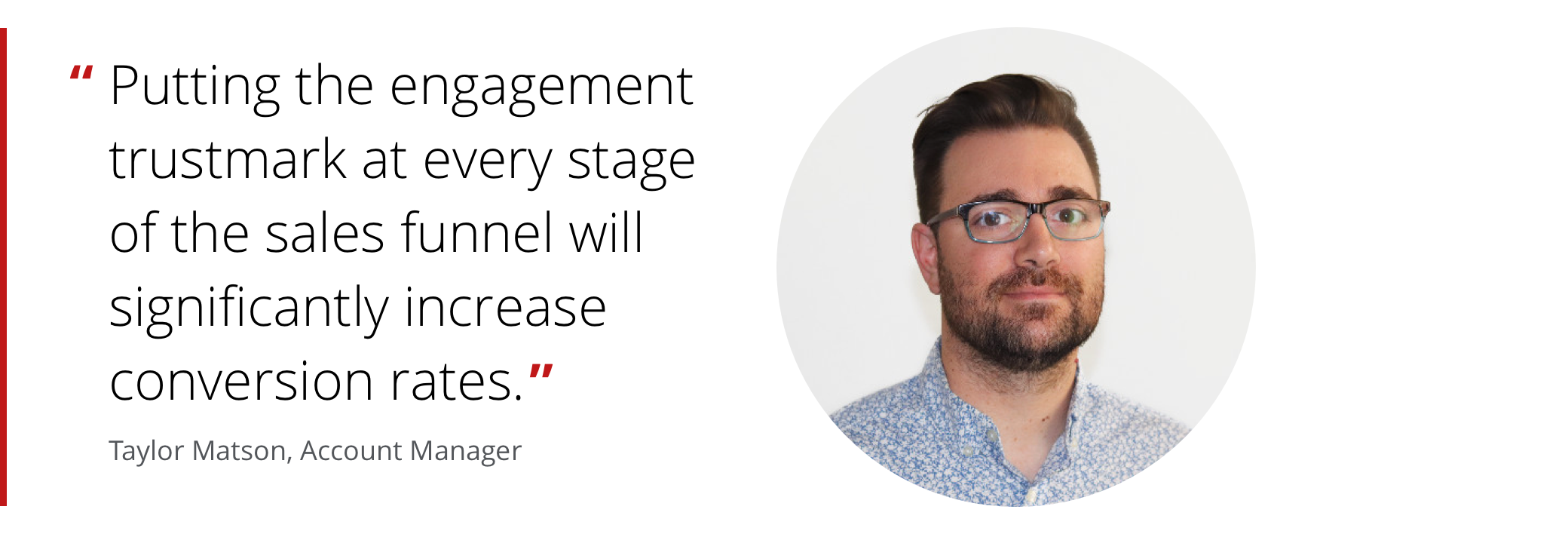Here's where you should be placing the McAfee SECURE trustmark
The McAfee SECURE certification is now TrustedSite Certification. TrustedSite Certification includes an extended portfolio of earned certifications and trustmarks that help alleviate even more concerns of online shoppers. Explore the new features here.
You probably already know that using the McAfee SECURE trustmark can reduce cart abandonment and lead to an increase in sales. After all, according to research conducted by the Baymard Institute, 73% of consumers say trustmarks make them feel like their personal information is secure when shopping online.
But a lot of that depends on how you use the service — where the trustmarks go, and understanding why they're valuable.
To give our readers some insight into how to get the most of the McAfee SECURE service, we asked some of the team who works directly with our customers day-in and day-out to give us their feedback and top recommendations on trustmark placement and usage.
Here's what they had to say:
Q&A: Best Practices for Trustmark Placement
Q: First off, can you explain the difference between the various trustmarks that make up the McAfee SECURE service?
Taylor Matson, Account Manager: There are three types of trustmarks: the floating trustmark, the engagement trustmark, and the Shopper Identity Protection trustmark.
Each trustmark has a specific purpose. The floating trustmark is a constant reminder of security. The engagement trustmark gives visitors added reassurance near areas where they may typically be hesitant to share personal information. And Shopper Identity Protection helps push consumers through the sales funnel at checkout pages. It’s important to use the entire system of trustmarks to maximize your results.
Q: Where should the floating trustmark go?
Taylor: Once our javascript code is placed on a site, the floating trustmark displays in the bottom right (or left) side of the screen. The floating trustmark should be placed on every page of a site. Something we like to tell our customers is it’s best to assume that every page on your website is the first page your customer sees because visitors can arrive at your site on many different pages, through links on other sites and search engine results.

Q: Where should the engagement trustmark be placed?
Taylor: At high engagement areas and conversion points.
Q: Can you explain more?
Taylor: Sure, basically anywhere someone is taking an action or providing you personal information that could result in them clicking away out of concern.
For example: registration fields, shopping cart, and download buttons. This will increase sign ups, new visitor registrations, and of course possible sales! Putting the engagement trustmark at every stage of the sales funnel will significantly increase conversion rates, especially near the checkout buttons and the credit card fields.
Q: Anywhere else?
Taylor: We also recommend placing it in the site header and footer. The trustmark in the footer is designed for security conscious consumers who, through way of internet tradition, will check the footer for any security information before providing personal information or checking out.
Placing the trustmark prominently in the header allows visitors to see it immediately without having to scroll or navigate. This will reduce your website abandonment rate and keep customers on your site.
Sean Kealy, Director of Sales: A new place to put it would be those pop-up "wait don't leave" widgets that sites are using so often now. Or the "spin to win!" add on that many Shopify sites use.
People know and see those as just lame attention grabbers. Make sure they know a site is secure and they will be more likely to engage.
Q: Can you tell us about the Shopper Identity Protection trustmark in more detail?
Taylor: The Shopper Identity Protection trustmark is our newest offering. It allows websites to offer their customers free identity protection, basically protecting them if their identity gets stolen.
Q: Why is that important?
Sean: In this "era" of big data breaches, ID theft is one of the biggest concerns people have when shopping online. They are concerned about their credit card information being taken and used to run up their credit cards, or worse, clean out their bank accounts.
Even if a visitor has added a product to the cart and made it all the way to the checkout page, there is no guarantee they will purchase. If they do not feel safe, they will not purchase. By placing the Shopper Protection trustmark immediately next to the 16 digit credit card input fields sites can address those concerns head on, dramatically reducing cart abandonment and increasing conversions.
Q: What other advice would you give to new or existing customers
Taylor: Ensure that you are using optimized placement (and don't be afraid to consult your account manager if you need assistance—we're here to help!). Use the most up-to-date trustmarks to ensure you have a modal-active trustmark with the most up-to-date visual design. Use a two-pronged approach to your security and consider an external scanning service to look for vulnerabilities on your application.

Sean: It's super important to put the floating trustmark on every page. If it shows up on some and not others, it might make customers think something is wrong or not secure with the page.
Even though the trend among designers is a clean, open website, it's not necessarily helping your bottom line. You can have the best-designed site in the world but if a visitor doesn't feel safe/secure, all your design efforts have gone to waste.
Q: Lastly, what’s the most creative placement you’ve seen for the engagement trustmark?
Taylor: Burtsbees.com has done a great job with the placement of their trustmark. They've included the trustmark in their popup check out tab, prominently advertising the fact that they have a secure site.
We’ve also seen a number of customers that have security specific pages on their site, similar to an “about us” page that specifically talks about how seriously they take security and the McAfee SECURE trustmark.
Sean: On a television infomercial. A person who claimed when I answered the phone that because I was too young I wouldn't know how "TV Famous" he was back in the 80's called and raved about how his new product 25minutehair.com was going to revolutionize the hair growth industry.
He then mentioned that in the infomercial industry more and more people are looking to visit a website rather than call in, but he knows that website security concerns can be an issue. After buying McAfee SECURE for his website, he asked and was given permission to place the McAfee SECURE logo on the "BUT WAIT THERE'S MORE — BUY NOW BY VISITING OUR WEBSITE" section of his newly released infomercial.
Not sure how things went after that but he told me he had already spent a decent amount on TV spots — so fingers crossed he is "TV Famous" once again!
Wrapping up
Now that you know where to put the trustmark, take a look at our technical implementation guide. It shows you exactly how to place the various trustmarks on your site, so you can convert security-concerned visitors into paying customers.